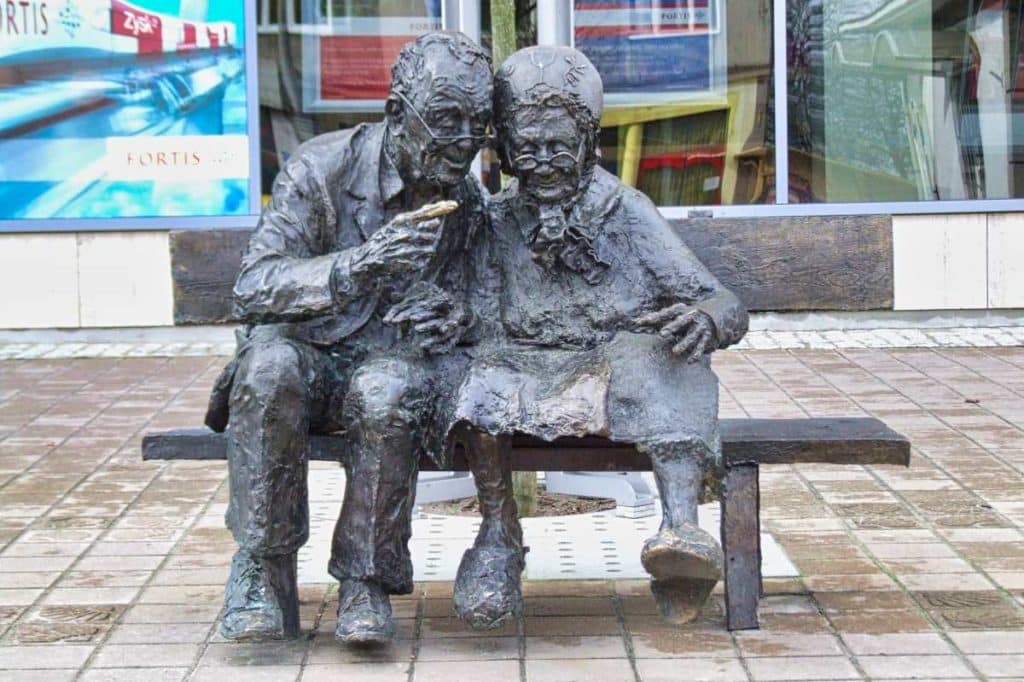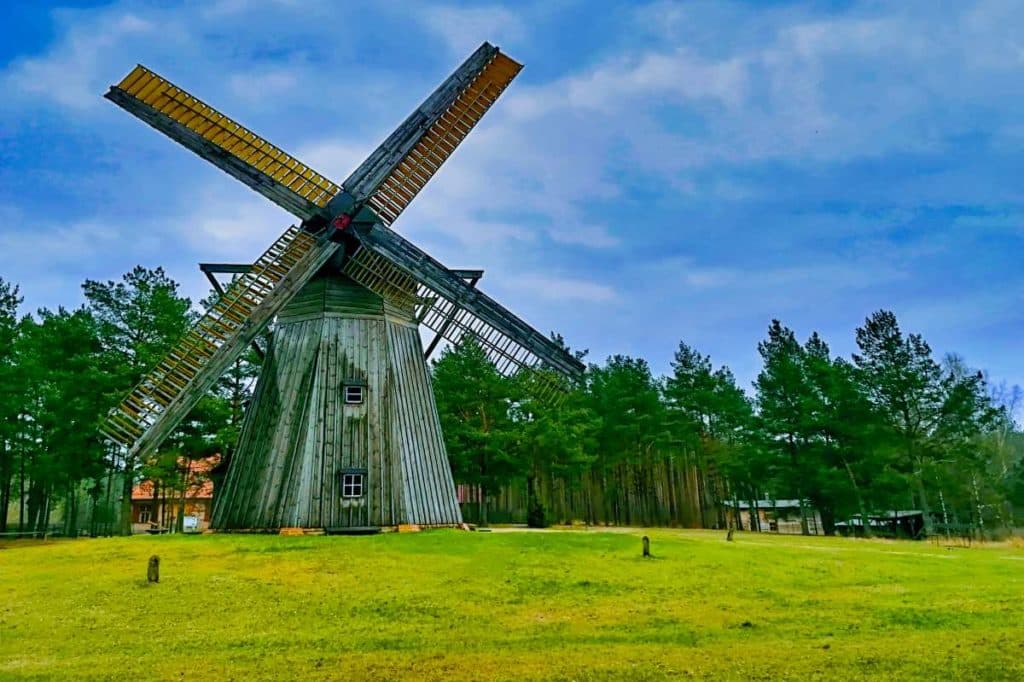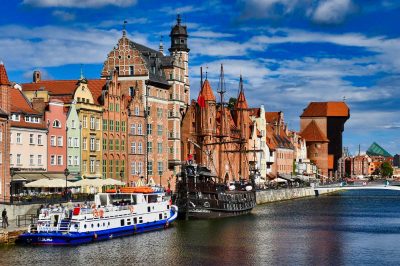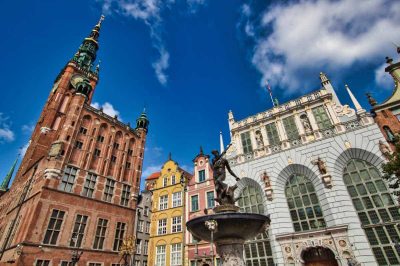In 1911, the ethnographer Ernst Seefried-Gulgowski wrote a book entitled “Von einem unbekannten Volke in Deutschland” (“About an unknown people in Germany”). The settlement area of the Kashubians is now part of Poland, but the attribution “unknown people” is still true today, at least for Western Europeans. Today, therefore, we take you to Pomerania, where west and south of Gdansk the Kashubians have been living for centuries. We want to introduce you to this West Slavic minority, which is little known in the West, and take a closer look at its history, culture and language.
Who are the Kashubians?
The Kashubians (Kashubian: Kaszëbi) are the descendants of Slavic tribes who settled in Pomerelia from the time of the Migration Period. Originally they lived in the entire northern area between the Oder and Vistula rivers. Over the centuries, however, they were subjected to strong assimilation pressure from the Germans and Poles for a long time, and their settlement area therefore continued to shrink. Their culture was often ridiculed and considered folklore. Even in communist times, there was a tendency to “shape” the society more homogeneously. A change in thinking took place only with the fall of communism, and today it is no longer considered a contradiction by the government to call oneself both a Kashubian and a Pole.
History and settlement area of the Kashubians
Little is known about the origins of the Kashubians, but they are probably descendants of the Pomorans, the “people living by the sea”. In the High Middle Ages the Kashubians were christianized by Poles, who pushed from the south further and further north into the settlement area of the then still pagan Kashubians. Around 1250, the settlement area of the Kashubians still included a wide strip, which reached from the present German-Polish border to just behind Gdansk. However, at the latest with the extinction of a local princely house at the end of the 13th century, the “self-determination” of the Kashubians came to an end, even if this term can be applied only in a limited way for the Middle Ages.

From then on, however, the Kashubian language faced increasing pressure to assimilate not only from the south, but also increasingly from the west. It was no longer only Polish, but increasingly also German that became a threat to the Kashubian language. This was also due to the fact that in the early 14th century the area became the property of the Teutonic Order (learn more about the Teutonic Order here). In the 15th century the area became Polish again, but in the course of the First Polish Partition it came under Prussian administration in 1772 and was henceforth called “West Prussia”. At that time, there were already only isolated Kashubian language islands in West Pomerania, and Kashubian was now spoken only west and south of Gdansk.
Today’s Kashubia is emerging
By the middle of the 19th century at the latest, an area had emerged that stretched from Schmolsin west of Leba to the Hela Peninsula and south to Konitz. The linguistic area became smaller once again. For about 100 years, however, there have been no major changes, so that Kashubian is spoken today in a broad strip that extends from the Hela Peninsula far into the hinterland. Of course, Polish dominates here as well and one can get along just fine with a knowledge of Polish, but there are many villages where Kashubian dominates and where Kashubian is taught in the schools.
Emergence of the Kashubian identity
In the 19th century, analogous to the development of the national idea in Poland and Germany, the Kashubians began to reflect on their own language and culture. Several societies were formed to preserve and maintain their culture, and folk songs, legends and poems were recorded and presumably saved from extinction. At the time of the Kulturkampf, but also before that, the Kashubians were caught between the fronts of the interests of the Germans and the Poles. Many Poles tried to polonize the Kashubians, the same happened from the German side. Florian Ceynowa described it at that time like this:
“Even today, all weapons are used to exterminate the remnants of the ancient inhabitants of Kashubia, killing them, if not physically, at least spiritually. And such a phenomenon in the XIX century! Do not answer me that the purpose of the state requires it by necessity! What purpose is noble enough to justify the barbarity of a national murder? What end is great enough to sanctify such a means? But one even believes that the work has already been accomplished; German magazines and pamphlets call out to us with delight: “They are Germanized!””
Dr. Florian Ceynowa (1817–1881)
Between the fronts
After World War I, Kashubia became part of the re-established Polish state, before being absorbed into the “Reichsgau Danzig-Westpreußen” during World War II. At that time, over 12,000 Kashubians were murdered by the Nazis, while others called themselves Germans and fought for German units. How big the trenches were that ran through Kashubian villages at that time can only be guessed. Since the end of the Second World War, the territory of the Kashubians has been part of Poland.
Hard years under communist rule
The communist period in Poland proved to be a major problem. Regional languages were not promoted here, quite the contrary. After World War II, Poland had for the first time become a state in which there were no longer any large groups of national minorities, in stark contrast to the interwar period, when Jews, Ukrainians and Belarusians made up large parts of the population, especially in the east of the country. Kashubian culture was often flaunted by those in power as village folklore; serious efforts to promote the language and culture of the Kashubians were not evident in centralist socialist Poland.
Since the fall of communism, this has fundamentally changed and today the Kashubians enjoy numerous privileges, of which more below.

Where the Kashubians live today
Since there was never a separate Kashubian state, the best way to determine the Kashubian habitat is by the area in which Kashubian was spoken. In the Middle Ages, the Kashubian language area extended much further west, roughly to the German-Polish border, and included the present-day voivodeships of Pomerania and West Pomerania. Today, Kashubia is limited to the areas you can also see on the map above.
The region where the Kashubians live is also called Kashubia (the Polish word Kaszuby means both the people and the settlement area of the Kashubians) or Kashubian Lake District or Kashubian Switzerland. This already says a lot about this picturesque region. The slightly hilly landscape has several hundred lakes and is ideal for a vacation, because the Polish Baltic coast can get quite crowded in the summer. By the way, the Kashubian region was defined as such only in 1999 by the Polish scientist Jan Modrawski. The main criterion for its delimitation was that in a place at least one third of inhabitants had to be Kashubians, which applied to 43 municipalities. The most important Kashubian localities are Puck, Wejherowo, Kościerzyna and Kartuzy.
The situation of Kashubians in Poland today
The vast majority of Kashubians see themselves as Poles and as Kashubians. While Poles speak of the “Fatherland” (ojczyzna), the Kashubians also have a mała ojczyzna, i.e. a “Little Fatherland”, which says a lot about their self-image. Unlike in the past, Kashubian is no longer suppressed today, but actively promoted. Kashubians, for example, have the right to take the A-levels (matura) in Poland in Kashubian, similar to Silesians in the south of the country. And as in the 19th century, today there are again numerous cultural associations, local initiatives that take care of the Kashubian language and culture.

Unlike in the past, however, there are now also institutions at the institutional level that take care of Kashubian, for example, a chair at the University of Gdansk that deals with the language and culture of the Kashubians. Moreover, by now even some street signs in the region are not in Polish, but in Kashubian and often bilingual.
However, Kashubian culture is now also cultivated to attract tourists to the region. Many Poles are curious and want to learn more about the Kashubians, although the boundaries between genuine interest and interest in kitschy displays and demonstrations in traditional costumes are often blurred. It is not least thanks to Henryk Muszyński, the former Primate of Poland (supreme bishop), that Kashubian can be heard again and again in church services today.
The Kashubian culture
For a long time, the life of the Kashubians was simple and characterized by hard and deprived everyday life in the Gdansk hinterland. Against this background, it is also understandable that superstitious tendencies persisted for a long time and fairy tales and legends played such an important role in the life of the Kashubians. Otherwise, especially Kashubian songs and Kashubian traditional costumes are still very present. Traditional Kashubian instruments, such as the devil’s fiddle or the Kashubian alphorn, are also not to be missed at Kashubian festivals. People are also proud about the long local ceramic tradition.
Kashubian fairy tales and literature
Florian Ceynowa, from whom the quote above also comes, was the first to collect old Kashubian legends and fairy tales and record them in writing. He was followed by numerous other researchers and today the fairy tales, which often deal with evil spirits, giants and dwarfs, are well researched. Unfortunately, most of them are available only in Kashubian or Polish. However, through this link you can download the five fairy tales “The Power of the Booklet”, “The Last Battle of the Stolems”, “The Treasure of Kashubia”, “Nikòlaj” and “The Brave Soldier and the Ghost” at least in German.
Kashubian cuisine
Over time, many recipes have evolved that have been carried forward and are now on the menu in Kashubian eateries. These include dishes such as Kashubian potato pie, potato pancakes, turnip soup, goose dishes, duck blood soup and leg of lamb with garlic. However, due to the proximity of the coast, Kashubian cuisine also features many fish dishes. Fish roe with fried onions is certainly not everyone’s cup of tea, but it is a classic of Kashubian cuisine. Herring in cream sauce is also one of the evergreens of Kashubian dishes. And the fact that potatoes in Kashubia are not only served as a pie or potato pancake, but also in the form of a cake, is probably only found here. The dessert menu also includes ruchanki, yeast egg cakes fried in fat and eaten with powdered sugar.
Kashubian – A unique language
“The Kashubians or Kassubians, of whom there are said to be three hundred thousand left today, are Old Slavs who speak a dying language peppered with German and Polish loan words.”
Günter Grass, “From the Diary of a Snail”
Some even say that Kashubian is older than Polish, as it has preserved many Old Slavic words that no longer exist in Polish. Linguistically, Kashubian, which belongs to the West Slavic languages, is most closely related to Polish and Sorbian. However, due to its location on the border between the historical settlement areas of Germans and Poles, many German words have also made it into Kashubian. Experts believe that about 10% of Kashubian words are of German origin.
Actually, however, one cannot speak only of the Kashubian language, because in fact several dialects exist, which can be roughly classified into the South and North Kashubian language family. This also explains why it took so long for a Kashubian written culture to develop, but to this day there is no real standardization. It is a bit like writing in dialect in Germany or Italy, the results will vary from village to village here as well.

Today there are still about 100,000 people who call Kashubian their mother tongue (many together with Polish). The number of ethnic Kashubians, if one can say that in view of their multi-identity, is estimated to be as high as 300,000. That there are still so many at all is not self-evident. For a long time Kashubian was not recognized as an independent language, and to this day there is no real standardization of the language. In the meantime, however, Kashubian has become a recognized regional language. Thanks to the possibility of graduating from high school in Kashubian and a chair at the University of Gdansk, which deals with the language and culture of the Kashubians, the Kashubians have experienced a revaluation and the continued existence of the language seems to be secured.

Famous Kashubians
One of the most famous Kashubians is the writer Aleksander Majkòwsczi (Polish: Majkowski). He studied and lived in Berlin, Munich and Greifswald and was a significant representative not only of the Kashubian but also of the Polish national movement. After his return to Poland, he worked for both a Polish and a Kashubian newspaper, making him a typical example of a Kashubian who defined himself as both a Pole and a Kashubian. He later founded several Kashubian associations, but he is best known as the author of “Żëcé i przigodë Remusa” (“The Adventurous Life of Remus”), which is still considered the most important work in the Kashubian language.
You have already met Florian Cejnowa above. His achievements for the Kashubian culture cannot be overestimated. He was a Kashubian and studied in Wroclaw and Königsberg. After participating in an anti-German uprising in West Prussia, he was arrested and sentenced to death. Fortunately, he was pardoned by King Frederick William IV and so he was able to study for a doctorate in Berlin. After being banned from practicing medicine, he devoted himself to researching the Kashubian language and later became the first writer to write in Kashubian. Today, several streets, libraries and schools are named after him.
Günter Grass also played a not insignificant role in popularizing Kashubian culture. He was the son of a Kashubian and a German. In several of his works, including “The Tin Drum”, the winner of the Nobel Prize for Literature addressed the Kashubian culture and thus made it known to a wider public for the first time in the West.
Donald Tusk has Kashubian ancestors. His maternal and paternal grandparents were Kashubians, and he himself was born in Gdansk. For the former Polish prime minister and president of the European Council, however, his origins became a problem. Tusk’s grandfather was drafted into the Wehrmacht because of his German citizenship (and presumably deserted shortly thereafter to join the Polish exile army). This circumstance has been used by Tusk’s opponents to portray Tusk as unpatriotic. Tusk is proud of his Kashubian origins and always emphasizes them.
Experiencing Kashubian culture
Today you can experience Kashubian culture in the region at numerous village festivals, in Kashubian restaurants or during Kashubian themed evenings. If you spend your vacation in Gdansk, you will come across Kashubian culture there as well. However, we would like to draw your attention to two special places, which deal with the life and history of the Kashubians.
Kashubian Museum in Kartuzy
The Kashubian Museum is located on the edge of the Kashubian Landscape Park and has existed for decades. On three floors you can learn about the history and culture of the Kashubians through numerous exhibits. Events such as cooking classes and other workshops are also held here from time to time, giving you a closer look at Kashubian culture. Cool feature: If you can’t visit the museum yourself, you can take a virtual walk through the exhibition building here.

Open Air Museum in Wdzydze Kiszewskie
The open-air museum in Wdzidzen has a long history. In 1906 it was founded as the first such institution in today’s Poland. Over time, the facility has been expanded and now resembles a village. Here you can learn about traditional crafts and visit farmhouses, manor houses, a school and even two churches, giving you an idea of the life of the Kashubians in the countryside between the 18th and 20th centuries.
Book tips
You want to learn more about Kashubian culture, history or language? Many books have not yet been published in German or English, but some are available!
Not exactly comprehensive at 63 pages, this book nevertheless offers a good insight into the culture, language and identity of the Kashubs.
No products found.
This book is quite old, but it is still one of the most interesting representations of the Kashubian language.
No products found.
You want to learn Kashubian? Then you can’t avoid this grammar of Kashubian, but you should have some knowledge of Polish to understand it.
No products found.
How did you like our trip to Pomerania? Have you ever been to Kashubia? Let us know and write us a comment. And feel free to follow Wild East on Facebook or Pinterest to stay up to date with the latest articles.




My name is Frank Plutowski. I have discovered the origin and historical significance of my last name if anyone is interested it is originally from Plutow/Kusnica located in the HEL Peninsula.
I think we are related! Are you part of the Kashubian Migration in the mid to late 1880s to the Ottawa Valley/and various parts of the northern states?